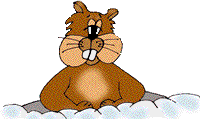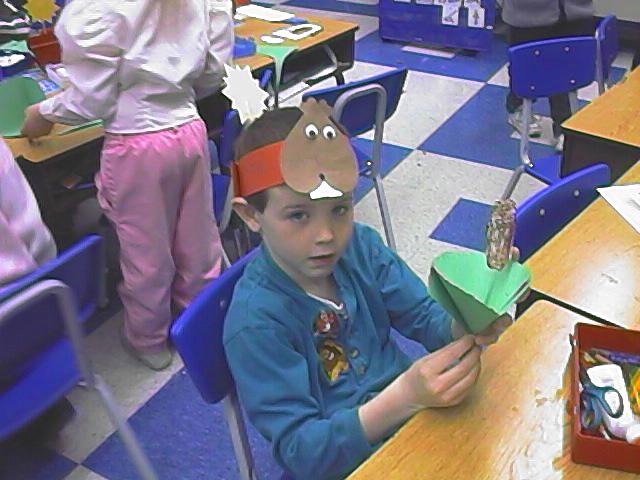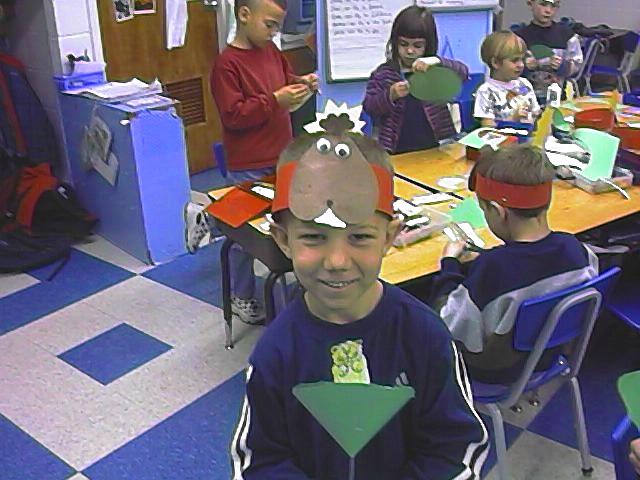
Great Groundhogs!
A one-day "mini" unit for that special February day!
Groundhog Day is a fun holiday with lots of potential for integrated instruction in the kindergarten classroom. Here are some fun ideas to explore this day with your kids!
Predicting and graphing
Okay, this activity needs to be done at least one day prior to the big day. Pose the all important question to your class: "Will the groundhog see his shadow?" Pass out index cards to the children and have them draw a picture of what they think will happen on Groundhog Day. Discuss the two options and what the pictures should contain. Elicit from the children that if the groundhog sees his shadow, the sun should be in the sky and the groundhog should be in the picture with his shadow. If he doesn't see his shadow, the sky should be cloudy and the groundhog in the picture with no shadow. Arrange the cards in two columns or rows on bulletin board paper and make comparisons by counting and making statements using more and less. Add a title to the graph and display.
Groundhog songs
My favorite groundhog song is by "Miss Jackie" Silberg.
Groundhog, groundhog,
Come on out and play.
It's a beautiful, beautiful, February day.
The sun is shining and the sky is blue.
Won't you come on out?
I want to play with you!
Groundhog, groundhog,
Come on out and play.
It's a gloomy, gloomy, February day.
The sun is shining and the sky is gray.
Won't you come on out?
I want to play today!
"Miss Jackie" has lots of other great songs too! I recommend any of her CD's or tapes!
Here are some silly groundhog songs written to go with familiar tunes. Many of them might not be for the early childhood classroom,but possibly after reading them you will be inspired to write a piggyback tune of your own for Groundhog Day or another occasion!
Check it out!
There are a couple of ways to see for yourself whether or not the groundhog sees his shadow. If you have online access you can to go http://www.groundhog.org and see the "official" groundhog, Punxsatawny Phil and his poetic prognostication and photos! Of course, it is necessary to step out and pretend that your students are the "local groundhogs" and see the local spring forcast! Maybe, if shadows are present a game of shadow tag is in order!
Shadow Science
Check out the length of shadows at various times during the day. Have the class leader for the day stand in a designated spot and measure his/her shadow at various points during the day. Why do the shadows move? Why do they change size? Interesting questions for discussion and possible further exploration.
Bring shadows inside. Use your overhead projector to project various objects onto a screen. Have the students identify the objects by their shadows. You could even practice recognizing shapes or letters this way for some extra fun.
Groundhog Crafts!
Make a groundhog pop up puppet. Each student will need a small groundhog blackline graphic that is about an eighth or tenth of a regular sheet of paper. They will also need a green sheet of construction paper, a circle pattern (approx. 8 inch diameter), a straw and tape. Students should trace around the circle on the green construction paper. Cut out the circle. To find the center of the circle fold it in half (it looks like a taco) and in half again (it looks like an ice cream cone). Unfold the paper and trace ONE line (radius) from the center to the outside of the circle. Then cut on the line to the center. Curve the circle on the cut to form a cone shape. Staple. Snip the point from the cone (to make a small hole). Around the circular part cut fringe (like grass). Set this aside. Color the groundhog blackline master and cut it out. Tape the straw to the back of the groundhog and place the straw through the hole in the upside down cone. Move the groundhog up and down to make him check for his shadow.
Make a groundhog headband. Each student will need 2 tiny brown hearts and one larger brown heart (about a quarter of a sheet of construction paper), 2 wiggly eyes, one small piece of white paper, an 18"by 2" strip construction paper (we used red), a 6" by 2" strip of construction paper, a straw and a symbol to represent the day's weather. The student assembles the groundhog head by turning the larger heart upside down. (What usually is the top is the cheeks now) Glue the two small hearts near the "point" of the larger heart for ears. Glue the wiggle eyes on the large heart. Draw a nose with a black crayon. Fold the white paper in half and cut to make two teeth. Glue under his cheeks. Glue the groundhog face to the middle of the longer construction paper strip. Set aside and allow to dry. Tape the weather symbol to the straw and tape the straw to the middle of the shorter strip. When the groundhog head is sufficiently dry, measure the strip to the child's head and staple the shorter strip around the back to complete the headband.
Learning Language the Groundhog Way!
Groundhog is a compound word! We call them "put together words" because two words are put together to create a new meaning. A fun way to introduce this concept is to brainstorm other compound words with your class and then construct "Put together" folders. After brainstorming a list of compound words then let each child choose a word to use. To make the folder the student will need to do a French door fold, which is the right and left quarter sections of the paper are folded to meet in the middle. Usually I make a master to make this procedure easier. On a paper turned horizontally, I print the words "Put it together" and have a line marking where the paper should be folded on each side. After the paper is folded, on the left door the student writes "See the" and the first part of the word he/she has chosen. On the right door the student writes "See the" and the second part of the word he/she has chosen. Both sides are illustrated. On the inside the student writes "See the" and the chosen word. Then this is illustrated. Let's say it was "groundhog". So on the left door it would say "See the ground" and the student would draw a picture of the ground. On the right door it would say "See the hog" and the student would draw a hog. On the inside under the words "Put it together" the student would write "See the groundhog." and draw a groundhog.
How about brainstorming a list of words that rhyme with groundhog! Dog, fog, jog, log, frog, etc.
Or brainstorm a list of words that begin with /gr/. Ground, grass, green, etc. Hmmmm....some of these have potential as alliterative sentences! Those could be fun to illustrate!
Groundhog sites
Check out these sites for more groundhog fun!
Groundhog unit at Teaching is a Work of Heart
Return to Main Page of Inside Kindergarten
© 1997 againes@netins.net

